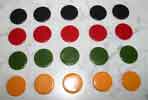Copyright © University of Cambridge. All rights reserved.
'Odd Times Even' printed from https://nrich.maths.org/
Show menu
Why do this problem?
This problem supports the development of the idea of generic proof with the children. This is a tricky concept to grasp but it draws attention to mathematical structures that are not often addressed at primary school level. In essence it explores one example to unpack the underlying structure in the mathematics that proves the general result. It is possible that only very few children in the class may grasp the idea but this is still a worthwhile activity which provides opportunities for children to explore odd and even numbers and the relationship between them. Proof is a fundamental idea in mathematics and in helping them to start this problem you will be helping them to behave like mathematicians.
By addressing the case of multiplying an even and odd number, a generic proof that multiplying an even and an odd number gives an even answer is developed based on the structure of odd and even numbers. The article entitled Take One Example will help you understand how this problem supports the development of the idea of generic proof with the children. Reading it will help you to see what is involved.
Possible approach
Invite the children to work in pairs. Ask each pair to choose an even and an odd number and multiply them together. It is important that the children are free to choose their own numbers, but it is probably most helpful if they choose numbers that are easy to model and that they are secure with. That is why we suggest the numbers 4 and 5 as our example in the question.
Suggest that they make a model of their numbers using apparatus that is widely available in the classroom. Resist pointing them to a particular type of apparatus or specific kind of diagram, unless they become stuck. It is important that they explore which apparatus is helpful, and which is not, as part of looking for the general structure in the particular example they have chosen. Encourage different pairs to share how useful (or not) they are finding a particular piece of apparatus. Resources such as Multilink cubes, squared paper or Numicon will turn out to be helpful. Some children may spend some time exploring creating models of their calculation and that may be valuable for them in developing their understandng of multiplication. Others may choose a model easily and move on to considering the structure of the example more quickly.
The challenge for the children is to see if they can see the general structure within their one chosen example and explain what they see in a convincing way.
Key questions
How would you like to represent these numbers being multiplied together?
What do you notice about the answer?
Can you see anything in your example that would work in exactly the same way if you used a different pair of odd and even numbers?
Can you say what will happen every time you multiply an even number by an odd number?
Can you convince your friend that this is true?
Possible extension
What will happen if you multiply an even number by an odd number?
Can you prove what will happen in a similar way to when you multiplied an odd number by an even number? Does the order matter?
What will happen if you multiply an even number by an even number? Will the oddness or evenness of the result always be the same? Can you prove it?
How about multiplying an odd number by and odd number? Can you find the general result here? Can you prove it by examining one example?
Possible support
It may be helpful to encourage children to use squared paper and place counters in the squares to represent their calculation. This may help them to see the structure more clearly and make a connection between multiplication and repeated addition. You will be able to look at the array one way or the other and see that it is the sum of a number of even numbers and therefore must be even.



